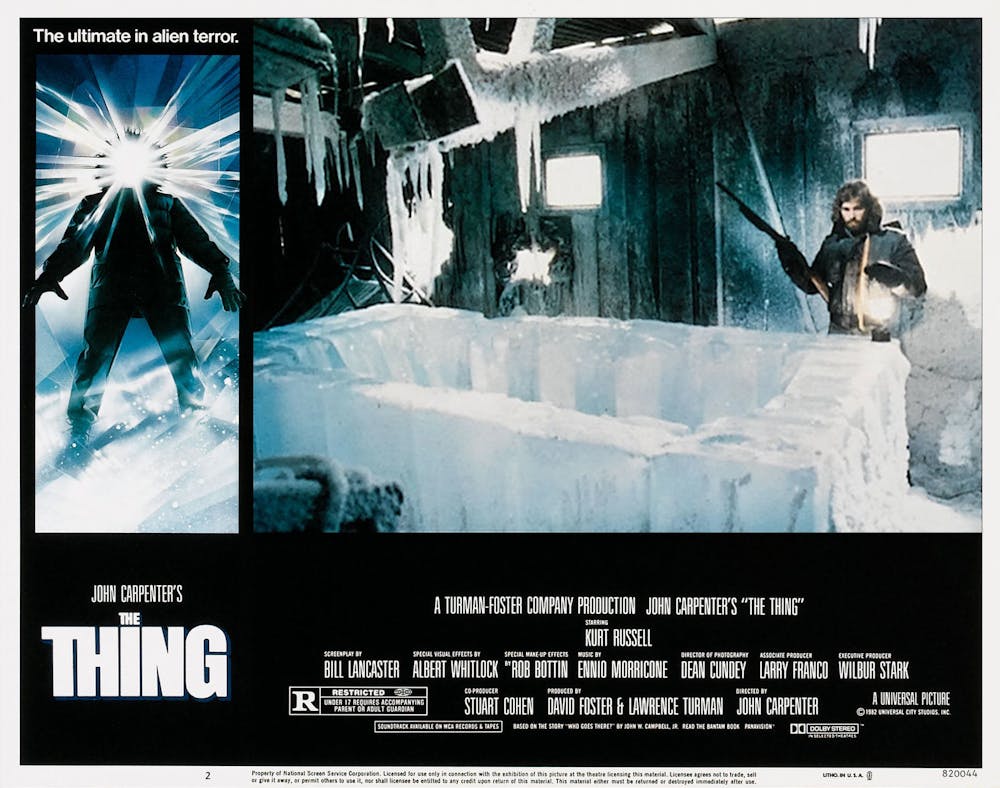On June 25, 1982, “The Thing” was released.
At the time, the film wasn’t seen as anything to write home about. But now, 41 years later, it’s found a cult following and has been reevaluated by audiences and critics.
But “The Thing” was only the beginning. Over the next decade, “The Thing’s” director, John Carpenter, released two more similarly bleak films, now dubbed the Apocalypse Trilogy.
Though they aren’t connected by any characters or events, the three films share similar themes and ideas. The characters in the Apocalypse Trilogy have their faith — in God, humanity and themselves — tested by forces beyond human understanding. The name of the trilogy comes from the films’ respective endings — all of which end in tragedy or on an ambiguous note. No one leaves unscathed in these films and that’s why they’ve stuck around for so long.
“The Thing” (1982)
“The Thing” is probably the most iconic and well-known of the trilogy, and for good reason. Its effects are the best in the business, its story is tight and melancholy and its ending has kept people debating for decades afterwards. I often credit “The Thing” with really setting off my love of filmmaking.
The film follows a group of American researchers in Antarctica who encounter a bizarre alien lifeform that can transform to look like anything or anyone. As paranoia rises, the group fights to overcome the alien, the elements and each other.
Carpenter’s mastery of the characters’ paranoia is utterly amazing. There’s never any dramatic irony – we find out who’s been taken over when the rest of the characters do, putting us right in their shoes. And, of course, those effects are utterly amazing. That defibrillator scene still hits every time.
There’s been so much conversation around “The Thing” that I can’t add much else, except to recommend it to everyone. After 41 years, it still holds up amazingly well.
“Prince of Darkness” (1987)
In my eyes, “Prince of Darkness” is the weakest of the trilogy – but that doesn’t make it a bad film. It’s the most overtly philosophical of the three, with the script sometimes devolving into long, rambling debates between Donald Pleasence and Victor Wong. Despite this, it still delivers outstanding horror imagery.
After the discovery of a strange artifact in the basement of an abandoned church, professor of theoretical physics, Howard Birack (Victor Wong), and a group of graduate students set out to investigate the phenomenon. As members of the group are slowly picked off, strange revelations and horrific happenings test their faith in their respective disciplines. Also, Alice Cooper is there as a lineless homeless man — I have no clue, either.
I love the horror aspects of this film. The recurring dream shared by the characters is filmed fantastically and adds such a creepy supernatural element to the film. The bug man – if you know, you know – is so cool, the use of computers to convey odd symbols is amazing and I love those mirror world effects.
While the script of “Prince of Darkness” is a bit confusing at points, the film overall is a great experience. I recommend it to anyone who likes slow-paced supernatural horror.
“In the Mouth of Madness” (1994)
“In the Mouth of Madness” is super underrated. It has an outstanding plot and some killer effects. I really don’t hear many people talking about it as much as they do “The Thing,” which is a shame since it’s so fantastic.
The film centers on John Trent (Sam Neill), an insurance investigator tasked with tracking down Sutter Cane (Jürgen Prochnow), a hugely popular horror novelist who has mysteriously disappeared with his newest book. Traveling with Cane’s editor, Trent begins to experience the same bizarre happenings described in Cane’s books. They’re all fictional – right?
The film’s surrealist tone and imagery absolutely rock. I constantly think about the “blue” scene, and driving at night has never been the same after seeing this film. There’s so many great concepts contained in one short movie. I can’t recommend it enough.
No matter your particular horror persuasion, the Apocalypse Trilogy offers up some of the best flicks out there. It’s an exploration into the many niches of the genre, from survival horror to Lovecraftian cosmic terror to surreal dream-like fear. It’s one long victory lap for Carpenter, who has proven himself one of the most iconic horror directors out there.
If you’ve got a few free nights in the future, check out these movies. While the films themselves may be apocalyptic, your enjoyment won’t be.






